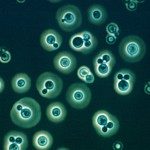Link to Pubmed [PMID] – 15155641
Infect. Immun. 2004 Jun;72(6):3359-65
Cryptococcus neoformans capsule structure modifications after prolonged in vitro growth or in vivo passaging have been reported previously. However, nothing is known about the dynamics of these modifications or about their environmental specificities. In this study, capsule structure modifications after mouse passaging and prolonged in vitro culturing were analyzed by flow cytometry using the glucuronoxylomannan-specific monoclonal antibody E1. The capsule structures of strains recovered after 0, 1, 8, and 35 days were compared by using the level of E1-specific epitope expression and its cell-to-cell heterogeneity within a given cell population. In vitro, according to these parameters, the diversity of the strains was higher on day 35 than it was initially, suggesting the absence of selection during in vitro culturing. In contrast, the diversity of the strains recovered from the brain tended to decrease over time, suggesting that selection of more adapted strains had occurred. The strains recovered on day 35 from the spleen and the lungs had different phenotypes than the strains isolated from the brain of the same mouse on the same day, thus strongly suggesting that there is organ specificity for C. neoformans strain selection. Fingerprinting of the strains recovered in vitro and in vivo over time confirmed that genotypes evolved very differently in vitro and in vivo, depending on the environment. Overall, our results suggest that organ-specific selection can occur during cryptococcosis.





